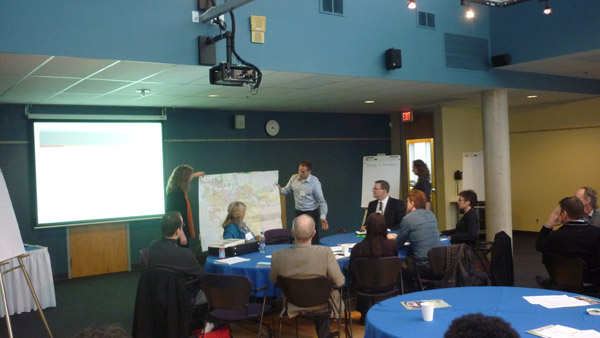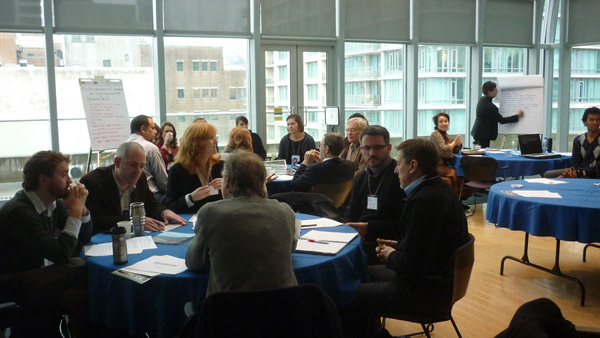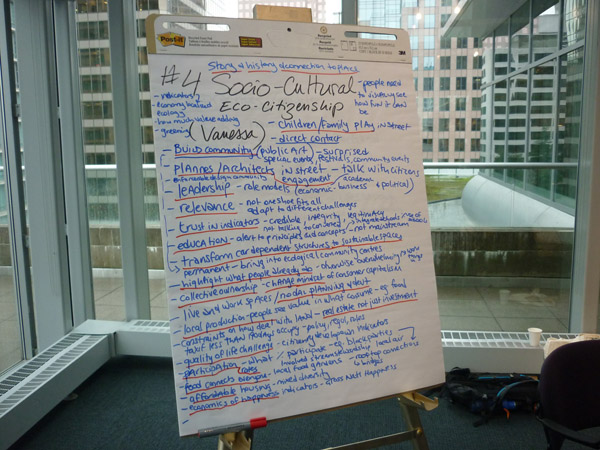by Sven Eberlein
The following is an excerpt from a series of workshops discussing the IEFS with a range of stakeholders and expert advisers in Vancouver, Canada, from February 9-14.
The original series was published on Daily Kos and can be found in its full length at the following links:
Carless in Vancouver, Part 1: Boots on the Ground
Carless in Vancouver, Part 2: Going for the high-hanging fruit
Carless in Vancouver, Part 3: Follow the Flow
Thursday, February 9th
The first IEFS workshop took place at the BCIT’s School of Construction and the Environment‘s Downtown Vancouver campus.
It was quite a conglomeration of luminaries that had gathered: Representatives from the City of Vancouver, Metro Van, industry, and real estate, as well as LCA experts and people like Gordon Price, Vanessa Timmer, Bill Rees, Sebastian Moffatt, and Jennie Moore.
Ecocity Builders Executive Director Kirstin Miller gave a brief update on the current blueprint of the IEFS, and the 15 conditions that would need to be addressed in order for a city to achieve basic “ecocity” status.
Next, we split up into 5 groups. Table 1 had the entire City of Vancouver crew ecocity-mapping their metro area, moving from a sprawling urban agglomeration to an eco-tropolis. They defined major centers, small town centers and neighborhood centers that could over time attract more density, be connected via public transit, bike and greenways, and restore agricultural land, habitat corridors, urban streams and parks between and around them.

Tables 2 and 3 were jamming on the bio-geo-physical conditions for the city organism, finding the best ways to track and assess the urban metabolism of air, water, food, and material flows. Sebastian Moffatt presented his methodology of analyzing the material flows and forms through a Sankey diagram, an intuitive and accurate visual tool to measure exactly what goes in and what comes out of a complex system.

Table 4, facilitated by One Earth Initiative‘s Executive Director Vanessa Timmer, focused on the socio-cultural component of the ecocity — ecocitizens! No question, that was my kind of table, as I firmly believe that our physical environment is a reflection of our inner state and that lasting sustainable urban ecosystems go hand in hand with a creative, educated and conscious citizenry. I think we all agreed that the best indicator for the state of eco-citizenship is the strength of the community bond. While each community has their own particular culture and customs, common themes revolved around food, art, creativity, public spaces, education, easy access, and affordable housing.

It’s important to remember that socio-cultural conditions are very much interrelated with physical conditions. For example, it’s hard to engage with your community when there are no pedestrian areas and public spaces, but how do you get support for such infrastructure changes when everyone is used to driving their cars from their jobs to their garages? The answer is that you have to have temporary trials to show how much more fun and fulfilling life can be in closer contact with your neighbors. Convert one parking spot into a parklet and people will understand what it means to hang out in the street. Close down a street for a day and business owners will realize that it brings more people into their stores. In order to build growing eco-citizenship, changing physical spaces has to go hand in hand with changing mental spaces.

Table 5 was tasked with evaluating how the City of Vancouver — which has done an initial data search based on the 15 IEFS conditions — had fared in its assessment so far, addressing the gaps as well as new insights that could be shared with other cities in the region. While lacking in specifics, their presentation summed up the bigger picture quite nicely: All our Economy and Ecology are belong together!

